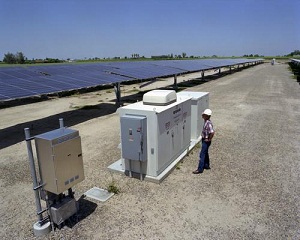Solar powers cleanup of New Jersey site
 The capped, contaminated remnants of the Rollins Environmental Facility in New Jersey will soon power its ongoing clean-up effort with a 1.5 megawatt photovoltaic (PV) array. Rollins is a former incinerator site on Raccoon Creek, a tributary to the Delaware River, with groundwater contamination. Before the contaminated water can enter either, it is cleaned by Clean Harbors Development, a wholly-owned subsidiary of Clean Harbors, LLC, which took over management of the site following its acquisition of Safety-Kleen.
The capped, contaminated remnants of the Rollins Environmental Facility in New Jersey will soon power its ongoing clean-up effort with a 1.5 megawatt photovoltaic (PV) array. Rollins is a former incinerator site on Raccoon Creek, a tributary to the Delaware River, with groundwater contamination. Before the contaminated water can enter either, it is cleaned by Clean Harbors Development, a wholly-owned subsidiary of Clean Harbors, LLC, which took over management of the site following its acquisition of Safety-Kleen.
Clean Harbors is an environmental services company, that is the primary company cleaning up the Gulf of Mexico, said Bill Geary, president of the Clean Harbors subsidiary.
Rollins has a sordid history. An explosion at the incinerator claimed six lives and injured at least 30 others in 1977, according to the Philadelphia Inquirer.
The site now is permanently capped and closed, said Geary. He explained that the contamination on the site is mainly in solid form, but water coming off the site is contaminated and must go through the company’s pump-and-treat system before it can enter the tributary. The decision to use PV to help remediate the contamination reflects an emphasis from “both the EPA and other state regulatory agencies that have been promoting adaptive use of these sites.”
“We’re hoping to start building the array in November. We’ll start ground preparation in the next few weeks,” said Geary. “Since the landfill is capped, one element of this project is it will not penetrate the cap of the landfill.” The non-intrusive array will be placed on hurricane-rated skids, he said. Since the array is being placed on top of the site’s cap, there is little danger of causing any additional contamination to be released.
When the array is completed it will supply all the power needed to operate the pump-and-treat operations during the day. The system will be grid-tied and net metered, with extra power produced by the system helping to lower the company’s electric bills during the day. During the night, the system will use grid supplied electricity to power its operations.
When remediation at the site is completed, an adjacent, uncontaminated property owned by Clean Harbors may be developed. If that happens, the PV array would help power the development, Geary said.
Geary explained it’s the first PV system Clean Harbors is developing, and it’s now “looking at the prospect of developing others around North America.” He said New Jersey was selected in part because of the state’s incentives. The company is considering similar PV systems at contaminated sites in California, Colorado, Utah, and Ontario.



